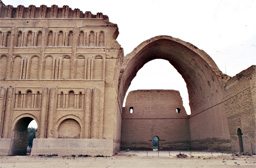Friday 5 February 2021
Iraq Calls for Iran’s Assistance in Restoration the Arch of Ctesiphon
BAGHDAD (IRNA) — Iraq’s Minister of Culture, Tourism and Antiquities Hassan Nazem in a meeting with Iran’s Ambassador to Iraq, Iraj Masjedi, on Thursday called for Tehran’s assistance in repairing the historical Arch of Ctesiphon (Ayvān-i or Taq-i Kasrā).

- Arch of Ctesiphon
- The Arch was built by Chosroes, after a campaign against the Byzantines in the year 540. Its main barrel vault is 35 m high, 25 m wide, and 50 m long.
Credit: Karl Oppolzer)
The Iraqi minister briefed the Iranian official on measures taken so far for reconstruction of the Arch of Ctesiphon and asked for Tehran’s assistance in restoring it as well as the environment around this historical monument.
The Cultural Adviser of the Islamic Republic of Iran in Iraq, referring to the previous follow-up and negotiations regarding the repair and reconstruction of the Arch, emphasized on the preservation and protection of this historical monument after reconstruction and called for the establishment of a mechanism for this issue.
Iran’s Minister of Cultural Heritage, Handicrafts and Tourism (CHHTO) Ali-Asghar Mounesan had previously declared that his country has reached an agreement with Iraq to repair the Iranian ancient monument of the Sassanid. Munesan said that the initial estimation by CHHTO for the purpose is around $600,000, after whose provision the Iranian archaeologists will be dispatched to Iraq.
The monument had been in danger of ISIS attacks in 2015-2016;
Located 35 km south of Baghdad, the Arch is now all that remains above ground of the city of Ctesiphon (modern day Salman-e Pak) that was, for seven centuries — from the 2nd century
During the meeting, the two officials also discussed issues such as agreement on joint cultural cooperation and development of religious tourism, formation of a bilateral cultural committee, and cooperation in the production of films.

